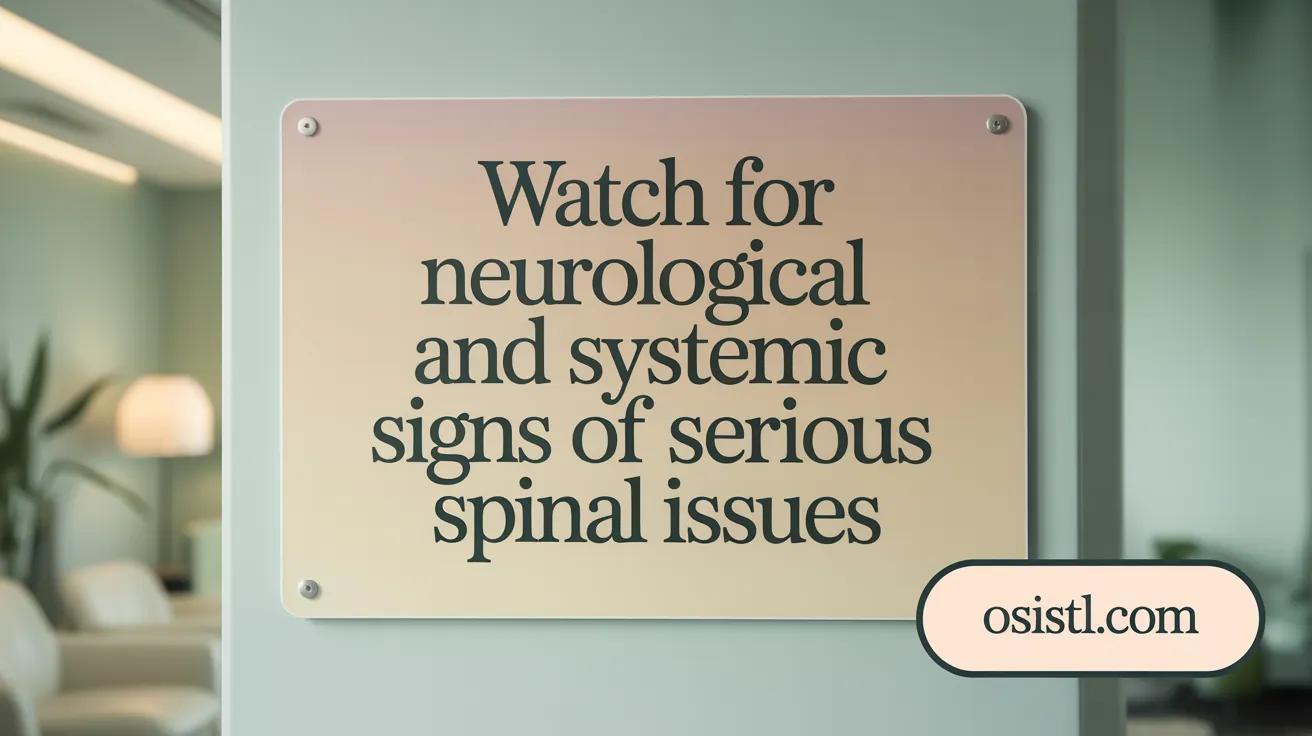Understanding the Urgency Behind Back Pain
Back pain is a widespread complaint that often resolves with simple self-care and conservative treatment. However, certain symptoms — known as red flags — signal serious underlying conditions that may require prompt medical evaluation or even surgical intervention. Recognizing these warning signs early is crucial to prevent permanent damage and improve patient outcomes. This article unpacks the critical red flags in back pain, guides readers on when to seek emergency care, and explains how medical professionals decide when surgery is warranted, ensuring patients receive timely and appropriate specialist care.
Recognizing Red Flags and Warning Signs of Serious Back Pain

What are the warning signs and red flags that indicate serious or urgent causes of back pain?
Serious back pain can sometimes be a sign of underlying life-threatening or disabling conditions requiring immediate medical attention. Key signs include severe or worsening neurological symptoms such as weakness, numbness, or tingling in the legs or arms, which may suggest nerve involvement or spinal cord compression (Red Flag Symptoms of Back Pain).
Bladder or bowel dysfunction, such as incontinence or retention, is a critical red flag indicating cauda equina syndrome—a medical emergency needing urgent surgery to prevent permanent damage (Signs You Need a Spine Specialist; Back Pain Emergencies).
Other urgent signs include severe weakness in limbs, unexplained weight loss, persistent fever, and night pain that awakens the patient (Common Back Pain Red Flags). History of recent trauma, especially in older adults with brittle bones, raises suspicion for fractures (Red flags in low back pain).
These signs are often accompanied by systemic symptoms like chills, malaise, or sweating, indicating infections such as osteomyelitis or spinal abscess (Red flags in back pain).
Timely identification of these warning signs, supported by thorough patient history and physical exam—including neurological assessment—is vital. Imaging tests like MRI or CT scans are used to confirm diagnoses such as tumors, infections, or injuries (Imaging techniques for back pain evaluation).
In essence, if you experience any of these warning signs, it’s crucial to seek prompt medical evaluation to rule out serious conditions and initiate appropriate treatment (When to See a Doctor for Back Pain).
Symptoms Signaling the Need for Immediate Medical Evaluation or Emergency Care
 Back pain can sometimes be a sign of a serious and urgent medical condition. Recognizing the symptoms that require immediate evaluation is crucial to prevent long-term damage or disability.
Back pain can sometimes be a sign of a serious and urgent medical condition. Recognizing the symptoms that require immediate evaluation is crucial to prevent long-term damage or disability.
One of the most critical red flags is the sudden onset of bladder or bowel incontinence. If you experience difficulty controlling urination or defecation, this may indicate cauda equina syndrome — a medical emergency that demands urgent surgical intervention to avoid permanent nerve damage.
Severe leg weakness, especially when accompanied by pain, is another warning sign. Weakness or numbness in the legs or feet can suggest nerve or spinal cord compression, which needs prompt diagnosis and treatment (Signs You Need a Spine Specialist).
Saddle anesthesia, a loss of sensation in the buttocks, inner thighs, and groin area, points to significant nerve involvement. This symptom, along with other signs like incontinence or paralysis, suggests spinal cord compression requiring urgent attention (Red flags for back pain).
Signs of spinal cord compression such as sudden paralysis, severe numbness, or difficulty moving limbs warrant immediate medical care. Delayed treatment can result in irreversible neurological deficits (When to see a spine surgeon).
If you experience any of these symptoms along with back pain, it is vital to seek emergency medical evaluation promptly. Early intervention can make a difference in outcomes and prevent lifelong disability (Back Pain Emergencies).
In summary, urgent evaluation is needed if back pain is accompanied by:
- Bladder or bowel incontinence
- Severe leg weakness
- Saddle anesthesia
- Other signs of spinal cord compression or paralysis (Neurological symptoms and back pain).
Timely medical attention can ensure appropriate diagnostics and life-saving treatment when necessary.
Neurological and Systemic Symptoms Indicative of Serious Spinal Conditions
 Serious spinal conditions often exhibit neurological and systemic symptoms that require prompt medical attention. Nerve-related issues such as persistent numbness, tingling, or weakness in the legs are key indicators of nerve compression or damage which can lead to long-term disability if untreated.
Serious spinal conditions often exhibit neurological and systemic symptoms that require prompt medical attention. Nerve-related issues such as persistent numbness, tingling, or weakness in the legs are key indicators of nerve compression or damage which can lead to long-term disability if untreated.
Bladder and bowel dysfunction are particularly concerning signs. Loss of control—such as incontinence or retention—along with saddle anesthesia (reduced sensation in the saddle area) suggests severe nerve involvement, notably cauda equina syndrome. This condition is a surgical emergency and needs immediate intervention to prevent permanent damage.
Clinical indicators of more severe conditions include rapid symptom progression, systemic signs like fever, unexplained weight loss, and night pain. A history of malignancy or recent infection enhances suspicion for cancerous or infectious causes affecting the spine.
Imaging modalities, especially MRI and CT scans, are essential for diagnosing these conditions. Abnormal findings such as nerve root compression, epidural abscess, or metastatic tumors guide the urgency and type of treatment.
In summary, symptoms such as ongoing numbness, weakness, bladder or bowel dysfunction, saddle anesthesia, and systemic illness signs signal serious underlying spinal diseases. Recognizing these signs early can facilitate timely diagnosis and prevent long-term neurological deficits.
Further information can be searched using terms like "neurological bladder bowel symptoms serious back pain diagnosis".
Differentiating Minor Back Pain from Conditions Requiring Surgical Intervention

How can one differentiate between minor back pain and symptoms that may require surgical intervention?
Minor back pain typically presents as a localized, dull ache that improves within a few weeks through home care measures such as rest, over-the-counter medications, or gentle activity. It usually does not cause neurological deficits or significant functional impairment. If the pain persists beyond six weeks or worsens despite conservative management, it might suggest a more serious condition (Back pain symptom overview).
Serious back pain that could require surgery often includes severe neurological symptoms like weakness, numbness, tingling, or loss of muscle function, especially if these symptoms worsen over time (Signs You Need Back Surgery, Signs You Need a Spine Specialist). Structural issues such as spinal instability, severe nerve compression, or deformities like scoliosis are also indications for surgical evaluation (Signs it's time for spine surgery, Cauda Equina Syndrome and related symptoms).
Conservative treatments, including physical therapy, medications, and injections, are often sufficient for minor problems. However, when symptoms are progressive or neurological deficits develop, these measures may no longer be effective, and surgical intervention might become necessary (Back Pain Treatment, Nonoperative Treatments for Lumbar Conditions).
Imaging studies like MRI or CT scans play a crucial role in evaluating structural causes (Imaging techniques for back pain evaluation, MRI as gold standard in back pain diagnosis). The duration of symptoms combined with imaging findings helps guide the decision-making process. If symptoms last longer than 6 to 8 weeks without improvement and imaging reveals significant pathology, surgery may be indicated (Persistent back pain lasting more than three months, Back pain red flags).
In summary, the key differences hinge on symptom progression, neurological involvement, response to treatment, and imaging results. Recognizing these signs early can prevent permanent damage and improve outcomes (Back pain seriousness symptoms, When to see a spine surgeon).
For more details, searching "Differentiating minor back pain from surgical back pain indications" can provide further information.
Medical Evaluation and Decision-Making Process for Spine Surgery
What does the evaluation process for back pain involve, and which signs influence the decision for surgical intervention?
The process begins with a thorough patient history and a detailed physical examination. Medical professionals look for red flags such as neurological deficits—including weakness, numbness, or tingling in the limbs—that suggest nerve compression or damage. They also assess symptoms' duration, severity, and impact on daily activities.
Imaging studies play a crucial role in guiding treatment plans. MRI is often the imaging modality of choice, especially for identifying nerve impingements, herniated disks, or spinal stenosis. Findings like spinal instability, deformity, or large herniated discs that do not respond to conservative treatment increase the likelihood of considering surgery.
Signs such as persistent intractable pain, worsening neurological symptoms, or structural abnormalities typically influence the decision-making process positively toward surgical intervention.
What criteria and guidelines do medical professionals use to determine when surgery may be necessary for back pain?
Guidelines incorporate several factors, including the presence of neurological deficits, findings from imaging, and the patient's response to conservative treatments like physical therapy and medications. Surgery might be indicated in cases of cauda equina syndrome, significant spinal instability, spinal cord compression, or when pain severely impairs quality of life and persists beyond typical durations of conservative management.
Additional criteria include evidence of structural issues on imaging, such as severe herniation or spinal stenosis, and the worsening of symptoms despite non-surgical interventions.
Ultimately, the decision is individualized, weighing the potential benefits of surgical relief against possible risks, with many cases requiring a multidisciplinary approach and shared decision-making.
Timing and Indicators for Consulting a Spine Surgeon

When should you see a spine specialist based on your symptoms?
Deciding when to consult a spine surgeon depends on how long your symptoms last, their severity, and whether they worsen over time.
Most importantly, persistent back or neck pain that lasts for several weeks to months, especially if it interferes with your daily activities, warrants medical evaluation. If pain persists beyond 4-6 weeks without improvement despite conservative treatment, such as medications or physical therapy, it may be time to see a specialist.
Additional signs include new or worsening neurological symptoms like weakness, numbness, tingling, or difficulty with hand or finger movements. These signs could indicate nerve compression or spinal cord issues that need prompt attention.
Those experiencing bowel or bladder incontinence, saddle anesthesia (numbness in the groin area), or severe pain radiating below the knees, should seek immediate care, as these may be symptoms of cauda equina syndrome, a medical emergency.
Risk factors such as recent trauma, a history of cancer, fever, or systemic illness also point to the need for urgent evaluation by a spine surgeon.
Imaging studies showing structural abnormalities—like fractures, deformities, or significant disc herniation—can further guide the timing of referral.
In summary, if your back or neck pain persists, worsens, or is accompanied by neurological deficits or red flag symptoms, consulting a spine specialist is advisable to determine if surgical intervention is necessary.
Taking Back Pain Seriously: Early Recognition and Specialist Consultation
Recognizing red flags in back pain is essential for timely diagnosis and intervention. While most back pain improves with conservative care, symptoms such as neurological deficits, bladder or bowel dysfunction, severe trauma, unexplained systemic signs, and failure to improve warrant urgent medical evaluation. Medical professionals rely on careful history, examination, and imaging to distinguish minor pain from conditions requiring surgery. Consulting a spine surgeon at the appropriate time — guided by symptom severity, risk factors, and response to treatment — can prevent permanent disability and optimize outcomes. Awareness empowers patients to seek help promptly, ensuring serious spinal conditions receive the specialized care they demand.
